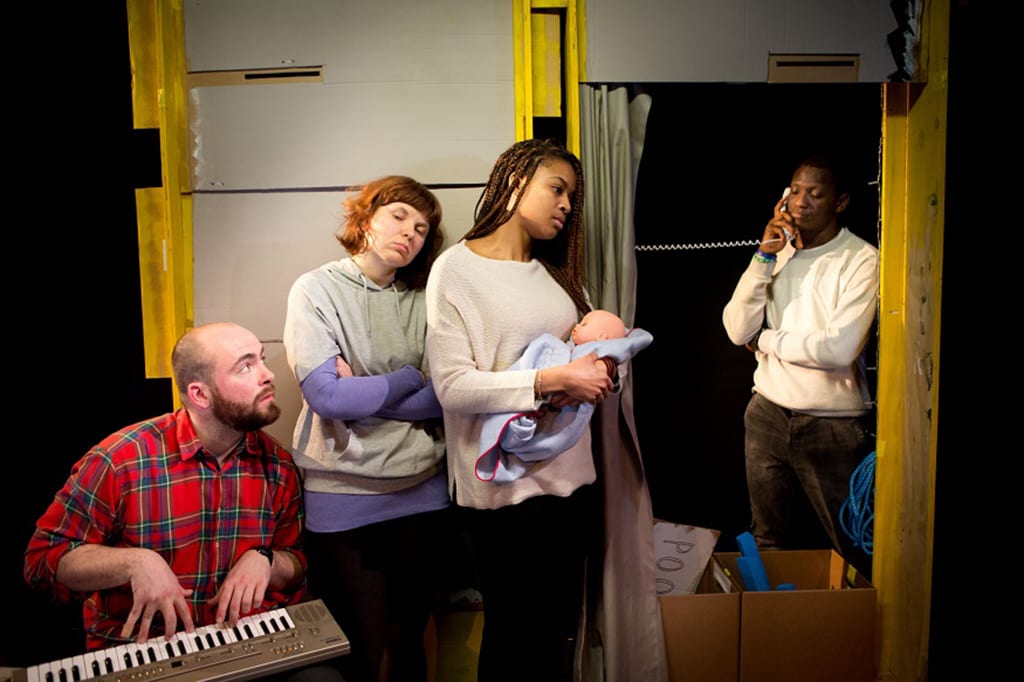The British press have been fixated on London’s housing crisis for the past five years or so. Hardly a day goes by without seeing a headline about soaring rent, poor conditions and impossible prices – the average price of a terraced house in Kensington and Chelsea is almost £4 million. In This is Private Property, four very different characters come together to try to explain this ever growing problem, relate their own experiences and stories and attempt to come up with a solution. However, Brian Logan’s production dealt with an interesting issue in a haphazard way, the tragicomic piece not quite hitting the mark.
Perhaps the best aspect of the play was the staging, which was suitably bare, and deftly captured the transitory lifestyle many young people living in London experience. Camden People’s Theatre made the most of their limited resources, producing sound effects like dripping taps, squeaking mice and wind with the actors’ voices; projecting interview clips with wealthy politicians on to white screens rather than using extra performers; making us the audience at a meeting for wealthy investors in a new property development, and pouring us drinks. These interactive touches involved us all, and made the small space feel like a community of equals all facing the same problem, not two distinct groups of audience and actors. All four actors performed with conviction and confidence, even whilst switching roles frequently. Racheal Ofori provided a particularly convincing turn as a single mother in search of a council house, providing a despondent turn to contrast with the play’s heartfelt but humorous tone. In this character, the real victims of the housing crisis were portrayed with sensitivity and repressed anger.
Certain elements of the script seemed disjointed and fractured. The play as a whole did not hang together and the audience were never allowed to forget that we were watching a play. This meta-theatrical technique can be effective, and in This is Private Property the switch between the actors playing their characters and playing themselves did serve to remind the audience that the housing crisis is a very real, concrete problem – it has not been manufactured for our entertainment. However, there was no central narrative, and the single mother story is never allowed the space it needs to develop properly. Constant interruptions of statistics, tasteless live music (including one especially awkward scene that involved a doll rapping) and speeches to the audience about new property developments stopped the story from having any genuine emotional impact. Whilst some of this was undoubtedly informative – rare is it to learn so much in just over an hour – a play should, surely, be about more than simply imparting information? If one leaves the theatre (as I did) without having experienced any emotional shift, something cannot be quite right. The play’s conclusion felt rushed and somehow unfinished, and ended later than it should have done. Just when one thinks it is about to deliver an appropriately sombre conclusion, it retreats into the realm of the bizarre once more. This could have been made effective, and was perhaps intended to make a comment on the bizarre, absurd situation of the London housing crisis itself. But in this particular instance, the messy conclusion served no apparent function, and the accentuated the ‘rich vs poor’ divide: one of the most simplistic and ill-informed aspects of the play’s political slant.
In conclusion, whilst This is Private Property is engaging and educative, it felt like a clumsy debate rather than a finished play. Whilst I learnt a lot and laughed a little, the play’s disorganised structure, lack of character development and poor script resulted in an experience that felt like a play still in its brainstorm stages.

